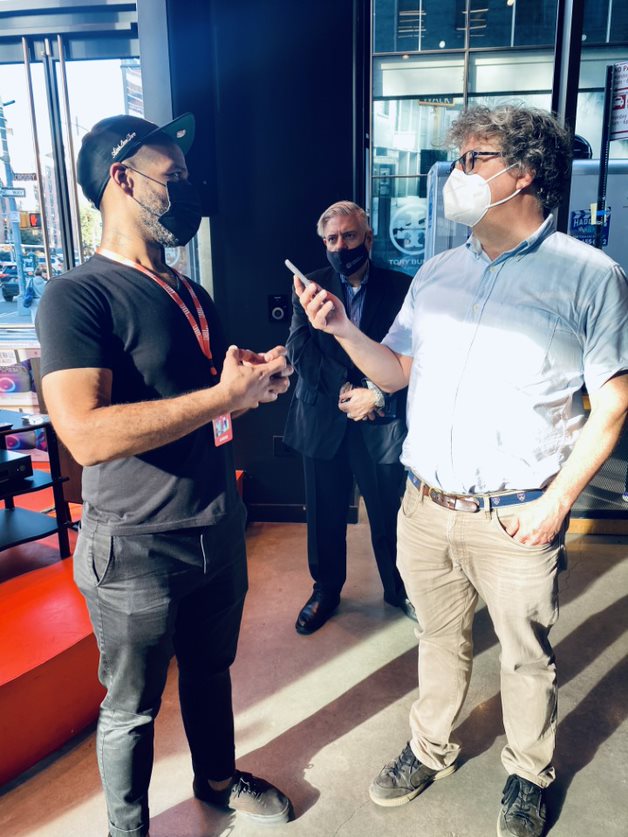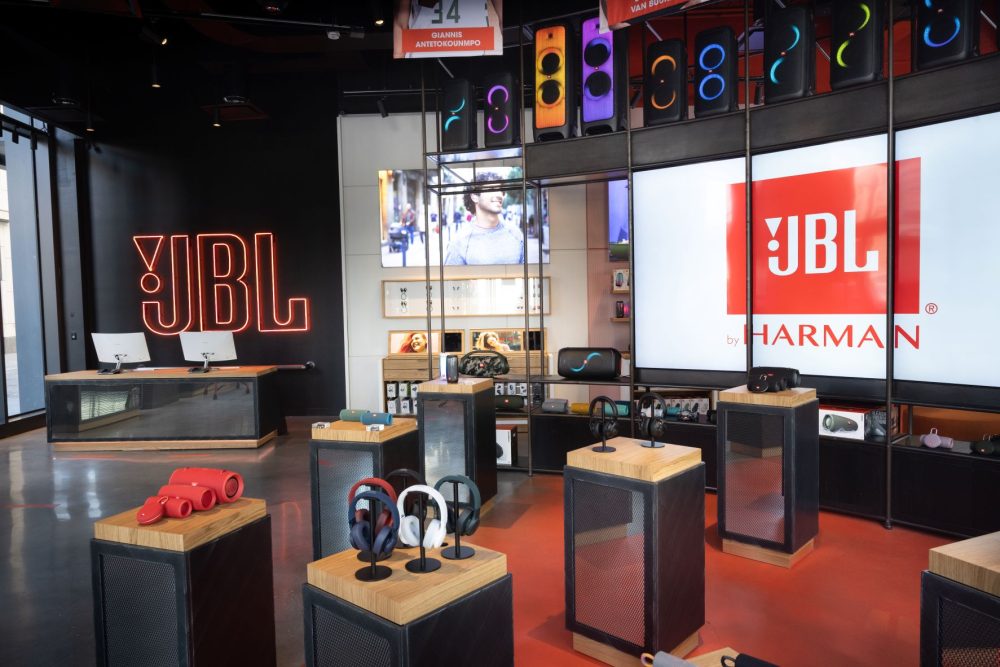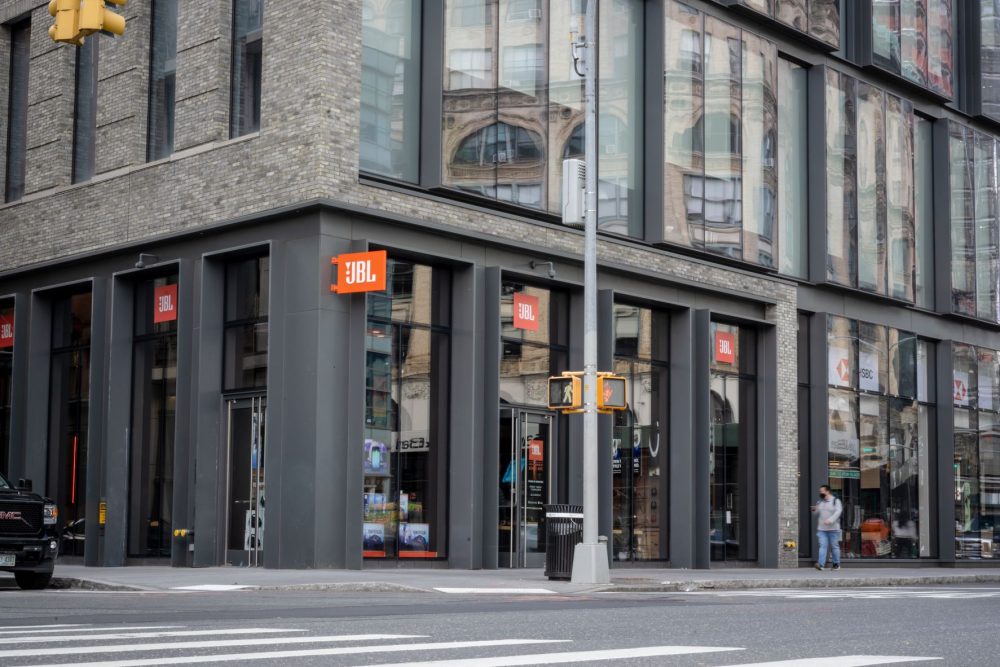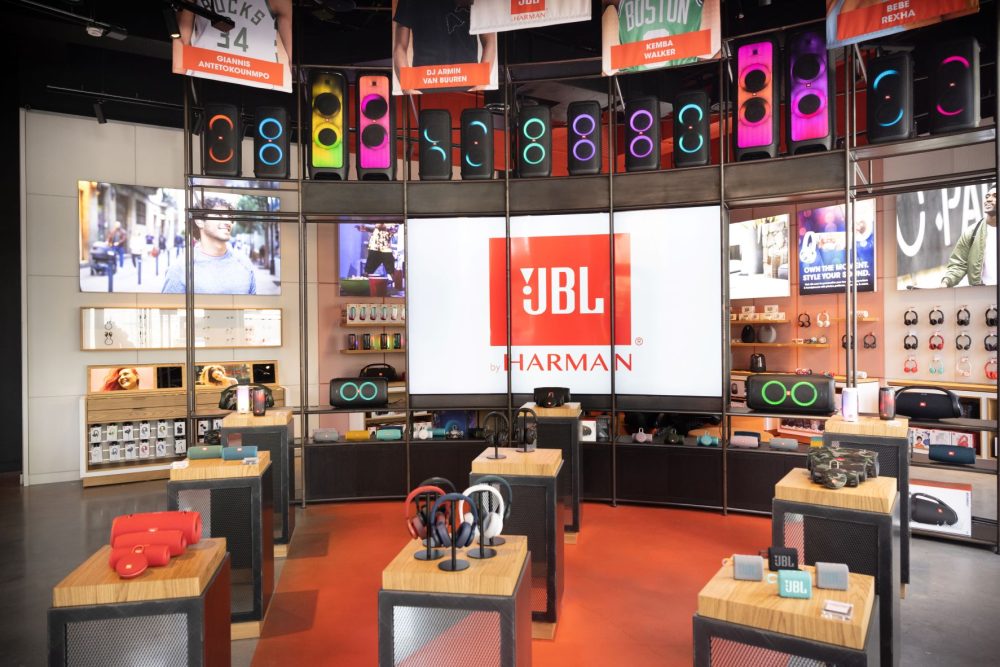Located on one of the busiest corners of New York City’s vibrant SoHo neighborhood, the new JBL Store shines a hip yet approachable light on the eponymous audio brand’s portable, gaming, and party speaker products. We asked Jamie Feuss, the Director, Retail Store Experience at Harman International, about the audio company’s distinctive approach to brand storytelling and retail at both its JBL and Harman Stores across the globe.
What’s the history of Harman as a retailer, including the JBL Store?
I was brought in when Harman wanted to launch a store back in 2013. My background was not just Tweeter for many years; I was also with Apple retail. So I spent a good amount of time out in that world of tech and electronics and opening up new stores in new parts of the country. Harman was obviously a manufacturer only then, and I was drafted to figure out where we should build stores.
My first suggestion was that we needed to build a store in SoHo, but for a lot of reasons, we ended up putting the Harman Store in Midtown, and that’s where we signed a lease for that store. Midtown was the right spot to expand, or actually shine a light on all of our brands, everything from Mark Levinson, Revel, and Infinity speakers to the entire line of JBL products including Pro, Synthesis, and portable. Midtown is a great tourist spot – people go to Rockefeller Center and Fifth Avenue, but the area doesn’t generate money, at least, per square foot. Still, it’s a great location for a marketing venue. And marketing and brand storytelling is a lot of what the Midtown store does. We also, pre-pandemic, used it for a lot of events, maybe two or three a month – everything from hosting a partner for our car business to having a pro dealer come to visit. In that space, we have a bigger stage area, we use Martin lights, which Harman makes, there, and there’s a bit more space and a downstairs showroom area that’s a bit more of a traditional high-end hi-fi store, where we shine a light on the complete line of Mark Levinson products, AKG headphones, Revel speakers, and more. We also have down there a full-blown JBL Synthesis theater, the kind you’d have at home if you were a studio director. So that’s the story we wanted to tell at that store, the story of Harman and Sidney Harman and how he expanded into the world of professional audio and make the Harman connection to consumers who maybe are driving their Lexus with Mark Levinson in it.
The JBL Store in SoHo is considerably different and seems to cater to a younger, hipper crowd with its mix of stylish portable audio and gaming products. How did this store come about?
The folks I reported to remembered that I told them we really should have a store in SoHo versus Midtown, even before the pandemic, because of the demographic that we wanted for JBL, and the number of customers that we would see was going to be better than the ones in the offices around Midtown. My experience, not just at Apple but also at Tweeter, was that you try to put your stores where people actually are.
We had worked with design and architecture firm Gensler on the Midtown store as well as our store in Munich, so I knew their team well and so did Harman. We were pleased with what they had done so far and they knew all our products well. And the architect-designers that we worked with have deep knowledge of retail in general, because Gensler has a retail division that has done lots of stores, not just in New York but across the world. So we did a deep dive with them and said it’s really about JBL, so let’s focus on this in SoHo.
So tell us a little bit more about how the design of the store keeps that focus on JBL?
The building we settled on was chopped up to be two different spaces and it was too small, but it’s located on a corner with great exposure. However, it’s in a landmark district, so we couldn’t put big signage out on the front window. And what you inherit is also the door and the soffits and the windows that they’ve built. If I had my way, I wouldn’t have any emollient in between the windows, I’d have it wide open, but it is what it is.
That said, we wanted people who might be driving by or walking by, to see. And on the corner, if people look in from the street, they can see what’s inside. We realized we could make the digital displays in the store do anything we want them to do, and we could do the same with all the lights inside. So at night, we glow a little bit, almost like a spaceship, and during the holidays, or during an event, we’ll change up the video and the lighting, so it always looks a little bit different.
So for us, it was really about how can we use a moment when people walk by, what allows people to see through and not cut off lines of sight, what’s going to draw people in, and Gensler helped us figure that part out.
We really just focus on JBL here, even in the lighting and color design. So the little dot that looks like an exclamation point in the JBL logo neon sign on the back wall actually represents the original horn that JBL founder James B. Lansing created for the speaker. Now, if you look at the store’s floor, the little stage is the same orange color and it’s shaped like the dot of that horn, which makes more sense when you look closely at the floor and see that we ran the rest of the horn all the way to the back, where even the ceiling and back wall are orange.
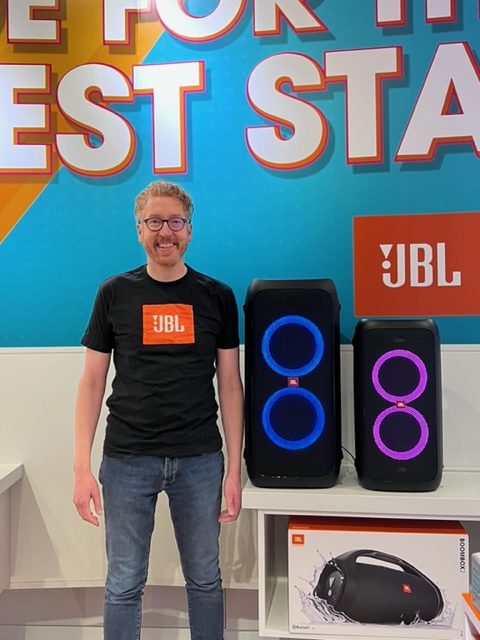
Since one of the main focuses of the store is portable audio, it makes sense that you would have a few Harman Kardon products in here as well, but why not also AKG, which also makes headphones?
AKG does a lot with professional headphones, and its consumer line is not as expansive. Beyond that, AKG doesn’t do any of the portable gear, so we decided that for this iteration, we’d keep it very narrow. But you’ll see just a little bit of Harman Kardon – some speakers and headphones – but not as expansive.
We all know that in retail, especially in electronics, people want something that sounds different, even just to compare. In this store, Harman Kardon is the more premium headphone and costs a little bit more, and we have some pretty strong selling Harman Kardon portables that really fit into this line for a good/better/best type of comparison, or maybe an alternative at a higher price point. So we brought in Harman Kardon specifically for that customer who asks, “Well, do you have anything else,” so we can say “Yeah, compare it to this, see what you think about this.” And that’s really why there’s a little bit of Harman Kardon here. I don’t look at it as a big departure from JBL, because it’s still portable, but it does look different. And there is a story there, but for the masses, our best-known brand today is JBL.
What are three things you’ve done that have contributed to the success of the store?
I think one thing that I’ve tried to do is give the store manager, Andre Taylor, a whole lot of independence. I’ve been a store manager, and I’ve been a regional guy. When we opened the store, I told him it was his. Previously he’d been an assistant manager at the Harman store on Madison Avenue, and before that, at Ralph Lauren. I told him: You’re going to own it, you’ll hire and manage the people, and I’ll support you. Whatever you need that I can do, I’ll do.
Harman was looking to us for direction with retail and Andre has a lot of retail experience, as do I, and our marketing team and salespeople who deal with our national vendors have retail experience because that’s who they call on. In addition, Harman trusts us to merchandise it, to display it, and to talk about it. We help the company with its story because before Harman got to retail, it wasn’t telling its story to a lot of people, including the people who worked there. Now all of our new hires visit our stores, so they can learn more about the brand story.
I think this helps to foster and create a culture that maybe there wasn’t enough of before. People didn’t know the big story about Sidney Harman. It’s a big story. At Apple, we talked about Steve Jobs. At Tweeter, we talked about the brand stories for the brands we carried. So in this case here at Harman, we’re threading the needle for our people, too, even by just talking about the fact that Sidney Harman was an interesting guy. He started making Hi-Fi right here in New York City. He manufactured the very first FM stereo receiver. That wouldn’t have happened if Harman Kardon didn’t build it, at least not in 1957. It’s a cool thing.
Brand evangelizing and exposure aside, what other takeaways do the Harman and JBL stores generate?
One of the interesting functions of the Harman store being so multi-faceted is that there’s some fluidity with brands and merchandising. In the beginning, we had more shelves and we showed more of our boxes, and a lot of that was for our own dealers or to sign up new dealers because in 2013 we weren’t as big as we are now. And now we have people coming in from all over the world to see our stuff — some of those folks open stores of their own selling our stuff. And we’re a partner there, especially for a lot of the tri-state-area dealers that are in the luxury and high-end space. Because I don’t employ a team of people who can go install a theater in your home. So if a customer wants that, I’m going to turn over the lead to one of our existing dealers, and they’ll come to do a site inspection and give them good/better/best options. I’ll be the liaison and the host because we also show and sell our $75,000 JBL speakers, and nobody else in New York does. So if you’re going to see them, you’re going to see them in our space.
The same is true of the portable gear at the JBL store, where dealers come just to see how we merchandise everything from the lava lamp speakers. and tower party speakers to the gaming gear and the headphones.
How many other stores does Harman have, JBL-branded or otherwise?
We have a store in Munich, for a number of reasons. In 1995, Sidney Harman acquired a company outside of Munich called Becker, which supplied radios for a lot of German cars. And then he bought AKG, which is about 90 kilometers away from Munich in Austria. Becker is now part of the auto division of Harman, which makes audio for various brands. If you get into a Lexus, it’ll be a Mark Levinson sound system; for Lincoln, it’ll be Revel, and if you get into a Mercedes or BMW, it’ll likely be branded Harman Kardon. And there are some others that are branded Infinity, as well as some of our other brands.
So I was conscious of the fact that even though not all car companies are manufactured in Munich, a lot of the execs live there, even if many of the corporate offices are spread out across Germany. And since our European offices are in Munich, we decided to open up there. The store there is a Harman store and it’s big enough to fit a few cars. We have a space dedicated to Harman Kardon, but most of the front of the store is dedicated to JBL. There’s also a mix of headphones from AKG and JBL as well. We have a separate studio where we house our higher-end brands such as Mark Levinson, JBL Synthesis, and Revel, and we even have a small movie theater there, because of a lot of interesting technology around digital surround. JBL is in 70 percent of the movie theaters in the U.S., and somewhere near half the movie theaters worldwide, so we wanted to make sure people got that story, too.
Then we also have a store in Yokohama, Japan. This one is located in an outdoor mall that’s a converted marina space and is right on the water. It’s close to Toyota’s offices, and it’s been a home run for us. It’s small and not super sexy, but JBL is a big brand in Japan, so it’s focused on everything that you see here, but no Pro and no Synthesis.
Does Harman plan to open up more JBL or Harman stores?
I’m the guy in the company that has been saying since I joined that we should be opening more stores. I’ve opened dozens of stores for Apple and Tweeter, but Harman or JBL doesn’t have to have loads of stores. I wish I didn’t have to say that. I would certainly open up a fleet of them willingly, but we’re not Apple, which had to open stores because it was getting dumped by dealers. There might not be an Apple if it hadn’t opened up those stores.
The way it’s set up now, I get to keep it small, pick great people, and allow them to be entrepreneurial and independent. And we all have to be very collaborative not just with the other store teams, but with the marketing teams around the country and the world, because we’re an international company that’s now owned by Samsung. We don’t have to use Samsung stuff, but we do when we need it for tech reasons (as we do with Apple stuff). And I think there could even be some interesting mashups between what we’re doing here at the JBL Store and Samsung products across the globe. But at the end of the day, what I think has been fun is creating the new stores for the strategic reasons that we have, and then convincing the folks that I report to that we should open stores in a few more places.
What are your goals for the next year?
My goals are to propel the stores to the next place because it was a challenge to keep the stores open during the pandemic. In 2022, I’m looking forward to doubling our business, and we will. We’ve already done well with a pandemic. So for me, that’s it.
And then longer term, I’d love to open some more stores. I think there could be some fun towns to be in that aren’t just where we have offices, but where the music industry is or where more of the car industry is.
Is there anything in the operation of these stores that has not gone the way you expected? If so, what did you learn from it?
Well, the pandemic, but in a lot of ways, it was a relief. We were originally supposed to open the JBL Store in SoHo in the Spring of 2020. We were designing and building at the same time and that’s no fun because you are constantly snapping your fingers. But the pandemic gave us more time to design and refine the design and get it completely ready, so that as soon as the city issued us the permit to build, we were ready. Whereas with the Harman store we were in design and build mode from the moment I started at the company and I didn’t know all the players, so it was tricky. As a result of the pandemic, we did the SoHo store for less than half the cost of the Harman store, and even less than what it cost to build the average Tweeter store, which we had down to a science. I knew we could do it for less.
What, in your opinion, is the role of brick-and-mortar retail in today’s omnichannel world?
It’s the same as it’s always been, whether in mail-order in the past or e-commerce today, the differentiator is your people. Of course, you also have to have good stuff to sell, but if you have great stuff and you have great people, you’ll always be successful at retail.
The store on Madison Avenue, just like any store on Fifth Avenue, is not going to make a lot of money, but we always strive to keep people engaged, show them a great experience, and tell the brand stories. And then if they have a need, we try to uncover what the need is and show them some appropriate choices. People don’t just buy from people that they like, but from people who like them. So I always encourage the team to try to connect with people to let them get to know us a little bit. Because if they like you, they’re gonna buy, but if you like them, too, you can make some long-term friends.

